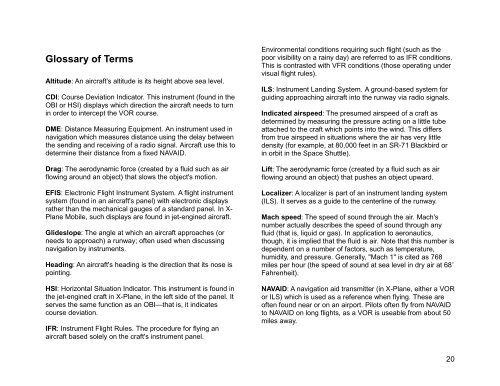X-Plane Helicopter Manual - X-Plane.com
X-Plane Helicopter Manual - X-Plane.com
X-Plane Helicopter Manual - X-Plane.com
- No tags were found...
You also want an ePaper? Increase the reach of your titles
YUMPU automatically turns print PDFs into web optimized ePapers that Google loves.
Glossary of TermsAltitude: An aircraft's altitude is its height above sea level.CDI: Course Deviation Indicator. This instrument (found in theOBI or HSI) displays which direction the aircraft needs to turnin order to intercept the VOR course.DME: Distance Measuring Equipment. An instrument used innavigation which measures distance using the delay betweenthe sending and receiving of a radio signal. Aircraft use this todetermine their distance from a fixed NAVAID.Drag: The aerodynamic force (created by a fluid such as airflowing around an object) that slows the object's motion.EFIS: Electronic Flight Instrument System. A flight instrumentsystem (found in an aircraft's panel) with electronic displaysrather than the mechanical gauges of a standard panel. In X-<strong>Plane</strong> Mobile, such displays are found in jet-engined aircraft.Glideslope: The angle at which an aircraft approaches (orneeds to approach) a runway; often used when discussingnavigation by instruments.Heading: An aircraft's heading is the direction that its nose ispointing.HSI: Horizontal Situation Indicator. This instrument is found inthe jet-engined craft in X-<strong>Plane</strong>, in the left side of the panel. Itserves the same function as an OBI—that is, it indicatescourse deviation.IFR: Instrument Flight Rules. The procedure for flying anaircraft based solely on the craft's instrument panel.Environmental conditions requiring such flight (such as thepoor visibility on a rainy day) are referred to as IFR conditions.This is contrasted with VFR conditions (those operating undervisual flight rules).ILS: Instrument Landing System. A ground-based system forguiding approaching aircraft into the runway via radio signals.Indicated airspeed: The presumed airspeed of a craft asdetermined by measuring the pressure acting on a little tubeattached to the craft which points into the wind. This differsfrom true airspeed in situations where the air has very littledensity (for example, at 80,000 feet in an SR-71 Blackbird orin orbit in the Space Shuttle).Lift: The aerodynamic force (created by a fluid such as airflowing around an object) that pushes an object upward.Localizer: A localizer is part of an instrument landing system(ILS). It serves as a guide to the centerline of the runway.Mach speed: The speed of sound through the air. Mach'snumber actually describes the speed of sound through anyfluid (that is, liquid or gas). In application to aeronautics,though, it is implied that the fluid is air. Note that this number isdependent on a number of factors, such as temperature,humidity, and pressure. Generally, "Mach 1" is cited as 768miles per hour (the speed of sound at sea level in dry air at 68˚Fahrenheit).NAVAID: A navigation aid transmitter (in X-<strong>Plane</strong>, either a VORor ILS) which is used as a reference when flying. These areoften found near or on an airport. Pilots often fly from NAVAIDto NAVAID on long flights, as a VOR is useable from about 50miles away.20














